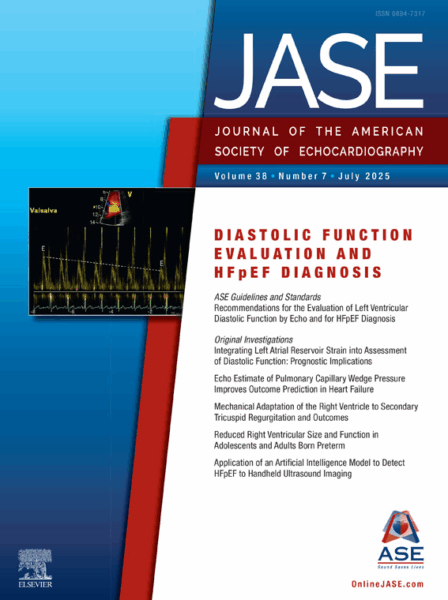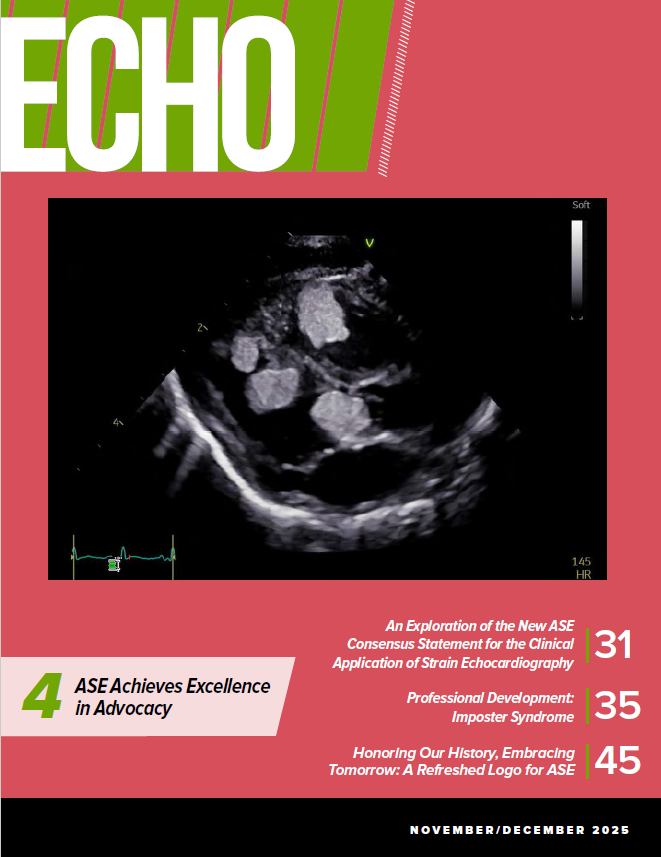The July issue of JASE is a focus issue on Diastolic Function Evaluation and Heart Failure with Preserved Ejection Fraction Diagnosis. The centerpiece is a new guideline titled, “Recommendations for the Evaluation of Left Ventricular Diastolic Function by Echocardiography and for Heart Failure with Preserved Ejection Fraction Diagnosis: An Update from the American Society of Echocardiography.” Lead author Sherif F. Nagueh, MD, FASE, remarks, “Many patients present for clinical care because of symptoms of shortness of breath. Heart failure is an important consideration, and its correct diagnosis is essential for timely and appropriate treatment. Echocardiography plays a major role in the diagnosis of heart failure. One reason patients have shortness of breath is increased capillary pressure in the lungs. This stems from increased left atrial pressure. The updated guidelines contain a new algorithm for the estimation of left atrial pressure and the grading of left ventricular diastolic dysfunction. It minimizes the number of patients where pressure cannot be determined by echocardiography, which is called indeterminate pressure. The new algorithm applies to patients in sinus rhythm and who do not have coexisting diseases as significant valvular heart disease or atrial fibrillation. The guidelines update also contains algorithms for specific cardiovascular diseases such as atrial fibrillation, pulmonary hypertension, and heart transplant recipients. For the first time, the 2025 diastolic function guidelines contain a section with specific recommendations for the diagnosis of patients with heart failure and preserved ejection fraction.”
Diagnosis. The centerpiece is a new guideline titled, “Recommendations for the Evaluation of Left Ventricular Diastolic Function by Echocardiography and for Heart Failure with Preserved Ejection Fraction Diagnosis: An Update from the American Society of Echocardiography.” Lead author Sherif F. Nagueh, MD, FASE, remarks, “Many patients present for clinical care because of symptoms of shortness of breath. Heart failure is an important consideration, and its correct diagnosis is essential for timely and appropriate treatment. Echocardiography plays a major role in the diagnosis of heart failure. One reason patients have shortness of breath is increased capillary pressure in the lungs. This stems from increased left atrial pressure. The updated guidelines contain a new algorithm for the estimation of left atrial pressure and the grading of left ventricular diastolic dysfunction. It minimizes the number of patients where pressure cannot be determined by echocardiography, which is called indeterminate pressure. The new algorithm applies to patients in sinus rhythm and who do not have coexisting diseases as significant valvular heart disease or atrial fibrillation. The guidelines update also contains algorithms for specific cardiovascular diseases such as atrial fibrillation, pulmonary hypertension, and heart transplant recipients. For the first time, the 2025 diastolic function guidelines contain a section with specific recommendations for the diagnosis of patients with heart failure and preserved ejection fraction.”
In response to this guideline is a commentary titled, “Guidelines for the Digital Era: A Vision for Artificial Intelligence in HFpEF.” This issue also contains a robust original investigations section with topics including left atrial strain and diastolic function assessment, pulmonary capillary wedge pressure assessment and outcome in heart failure, mechanical adaptation of the RV in secondary tricuspid regurgitation and patient outcomes, reduced RV size and function in adolescents and adults born preterm, as well as a novel deep learning model to predict pharmacologic closure of patent ductus arteriosus in premature infants. Three editorial comments accompany those reports, and a brief research communication discusses the application of an artificial intelligence model to detect heart failure with preserved ejection fraction to handheld ultrasound imaging. Rounding out this issue are a few letters to the editor about considering the Doppler angle effect wherever the proximal isovelocity surface area method is utilized.
In this month’s President’s Message, ASE introduces the vision of its new president, David Wiener, MD, FASE: align with collaborators, sustain our workforce, and engage current/future members.
A focus issue on chamber quantification is set for publication in 2026. Papers that address any aspect of echocardiography in quantitative assessment of the cardiac chambers should be submitted by August 1, 2025. Please direct questions to JASE managing editor
The July issue of JASE is a focus issue on Diastolic Function Evaluation and Heart Failure with Preserved Ejection Fraction Diagnosis. The centerpiece is a new guideline titled, “Recommendations for the Evaluation of Left Ventricular Diastolic Function by Echocardiography and for Heart Failure with Preserved Ejection Fraction Diagnosis: An Update from the American Society of Echocardiography.” Lead author Sherif F. Nagueh, MD, FASE, remarks, “Many patients present for clinical care because of symptoms of shortness of breath. Heart failure is an important consideration, and its correct diagnosis is essential for timely and appropriate treatment. Echocardiography plays a major role in the diagnosis of heart failure. One reason patients have shortness of breath is increased capillary pressure in the lungs. This stems from increased left atrial pressure. The updated guidelines contain a new algorithm for the estimation of left atrial pressure and the grading of left ventricular diastolic dysfunction. It minimizes the number of patients where pressure cannot be determined by echocardiography, which is called indeterminate pressure. The new algorithm applies to patients in sinus rhythm and who do not have coexisting diseases as significant valvular heart disease or atrial fibrillation. The guidelines update also contains algorithms for specific cardiovascular diseases such as atrial fibrillation, pulmonary hypertension, and heart transplant recipients. For the first time, the 2025 diastolic function guidelines contain a section with specific recommendations for the diagnosis of patients with heart failure and preserved ejection fraction.”
In response to this guideline is a commentary titled, “Guidelines for the Digital Era: A Vision for Artificial Intelligence in HFpEF.” This issue also contains a robust original investigations section with topics including left atrial strain and diastolic function assessment, pulmonary capillary wedge pressure assessment and outcome in heart failure, mechanical adaptation of the RV in secondary tricuspid regurgitation and patient outcomes, reduced RV size and function in adolescents and adults born preterm, as well as a novel deep learning model to predict pharmacologic closure of patent ductus arteriosus in premature infants. Three editorial comments accompany those reports, and a brief research communication discusses the application of an artificial intelligence model to detect heart failure with preserved ejection fraction to handheld ultrasound imaging. Rounding out this issue are a few letters to the editor about considering the Doppler angle effect wherever the proximal isovelocity surface area method is utilized.
In this month’s President’s Message, ASE introduces the vision of its new president, David Wiener, MD, FASE: align with collaborators, sustain our workforce, and engage current/future members.
A focus issue on chamber quantification is set for publication in 2026. Papers that address any aspect of echocardiography in quantitative assessment of the cardiac chambers should be submitted by August 1, 2025. Please direct questions to JASE managing editor Debbie Meyer at [email protected].
Tune into our Author Spotlight page for interviews between JASE Editor-in-Chief Patricia Pellikka, MD, FASE, and authors of recently published papers. July’s interview features Sherif F. Nagueh, MD, FASE, discussing ASE’s newest guideline, “Recommendations for the Evaluation of Left Ventricular Diastolic Function by Echocardiography and for Heart Failure with Preserved Ejection Fraction Diagnosis: An Update from the American Society of Echocardiography.”
Please see the July ASE Education Calendar for a listing of educational opportunities far and wide.
Tune into our Author Spotlight page for interviews between JASE Editor-in-Chief Patricia Pellikka, MD, FASE, and authors of recently published papers. July’s interview features Sherif F. Nagueh, MD, FASE, discussing ASE’s newest guideline, “Recommendations for the Evaluation of Left Ventricular Diastolic Function by Echocardiography and for Heart Failure with Preserved Ejection Fraction Diagnosis: An Update from the American Society of Echocardiography.”
Please see the July ASE Education Calendar for a listing of educational opportunities far and wide.
Publish date
July 9, 2025
Related News



ASE News
